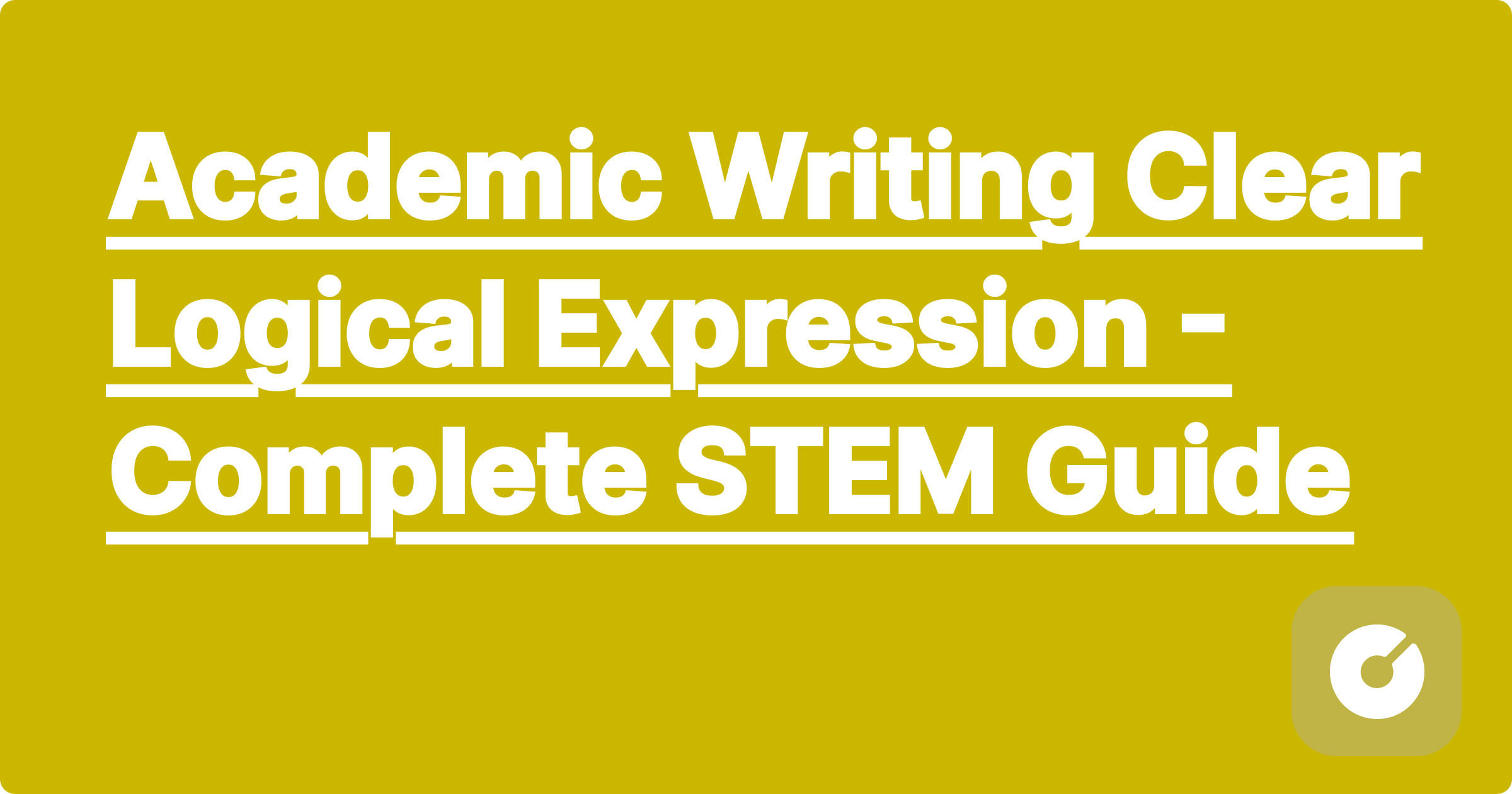## Mastering Academic Writing: Clear, Logical Expression for STEM Success
**1. Introduction: Beyond the Lab Coat – Communicating Your Genius**
You've spent countless hours in the lab, wrestling with complex equations, meticulously analyzing data, and pushing the boundaries of scientific understanding. But what good is your groundbreaking research if you can't communicate its significance effectively? In the competitive world of STEM, clear and logical expression in your academic writing is as crucial as your experimental prowess. This isn't just about getting good grades; it's about securing grants, publishing your findings, collaborating effectively, and ultimately, advancing your career. This post provides a practical guide to mastering academic writing, specifically tailored for STEM students, equipping you with the skills to express your technical brilliance convincingly.
**2. Core Concepts: The Building Blocks of Clear Scientific Communication**
Effective STEM writing hinges on several key principles:
* **Precision:** Avoid ambiguity. Use precise terminology and define any specialized terms clearly the first time they appear. Vague language has no place in scientific writing. Instead of "a lot of data," specify "n=1000 samples." Instead of "the reaction was fast," quantify the rate constant.
* **Clarity:** Structure your arguments logically. Every sentence should build upon the previous one, leading the reader seamlessly through your reasoning. Avoid jargon unless absolutely necessary and always explain its meaning.
* **Logic & Argumentation:** Your writing should present a compelling argument. This involves clearly stating your hypothesis, presenting evidence supporting your claims, addressing potential counterarguments, and drawing well-supported conclusions. Employ deductive and inductive reasoning appropriately.
* **Objectivity:** Maintain an objective tone, avoiding subjective opinions or personal biases. Focus on facts, data, and evidence. Use passive voice strategically to emphasize the experiment rather than the researcher (e.g., "The sample was analyzed..." instead of "I analyzed the sample..."). However, don't overuse passive voice; it can make your writing sound stilted.
* **Conciseness:** Avoid unnecessary words or phrases. Every sentence should serve a purpose. Get straight to the point. Strong verbs and precise nouns are your allies.
* **Structure & Flow:** Follow a logical structure with clear headings, subheadings, and transitions between paragraphs. Use visual aids (tables, figures, graphs) to enhance understanding and present complex data efficiently. Ensure smooth transitions between sections to maintain the reader's engagement.
**3. Practical Examples and Case Studies:**
**Case Study 1: Poorly Written Abstract:**
"We did an experiment and it was interesting. The results were kinda unexpected, and we think it might be important, maybe. Further research is needed."
**Revised Abstract:**
"This study investigated the effect of temperature on the catalytic activity of platinum nanoparticles in the oxidation of carbon monoxide. Contrary to expectations, we observed a decrease in catalytic activity above 300°C. This unexpected finding suggests that thermal deactivation of the nanoparticles is a significant factor, warranting further investigation into the long-term stability of platinum catalysts under high-temperature conditions."
**Case Study 2: Improving Clarity in a Results Section:**
**Poorly Written:** "The data shows that there's a connection between the two variables. It's pretty significant."
**Revised:** "A strong positive correlation (r = 0.92, p < 0.001) was observed between variable X and variable Y, indicating a statistically significant relationship."
**Example: Code Explanation**
Let's say you're explaining a Python function for data analysis:
**Poorly Written:** "This code does stuff with the data. It's important."
**Revised:** "This Python function `clean_data(dataframe)` preprocesses a Pandas DataFrame. It first removes rows with missing values using `dataframe.dropna()`. Then, it converts the 'date' column to datetime objects using `pd.to_datetime()`. Finally, it standardizes numerical columns using `StandardScaler()` from scikit-learn to ensure that all features have zero mean and unit variance."
**4. Step-by-Step Implementation Guide:**
1. **Planning:** Before writing, outline your argument and structure. Create a detailed plan with headings and subheadings to guide your writing process.
2. **Drafting:** Focus on getting your ideas down on paper first. Don't worry about perfect grammar or style at this stage.
3. **Revising:** Review your draft for clarity, logic, and conciseness. Ensure that your argument flows smoothly and that your evidence supports your claims.
4. **Editing:** Check for grammar, spelling, punctuation, and style errors. Use a style guide (e.g., Chicago Manual of Style, APA Style) consistently.
5. **Proofreading:** Carefully read your final draft to catch any remaining errors. Consider asking a peer to review your work for feedback.
**5. Recommended Tools and Resources:**
* **Grammarly:** A grammar and style checker that helps identify and correct errors.
* **ProWritingAid:** Provides in-depth analysis of your writing style, suggesting improvements for clarity, conciseness, and readability.
* **Zotero/Mendeley:** Citation management tools to organize your references and generate bibliographies automatically.
* **Overleaf:** A collaborative LaTeX editor, ideal for creating complex documents with mathematical equations and figures.
* **Graphing software (e.g., MATLAB, Python with Matplotlib):** Essential for visualizing data effectively.
**6. Conclusion and Next Steps:**
Mastering clear and logical expression in academic writing is an ongoing process that requires practice and dedication. By focusing on precision, clarity, logic, objectivity, conciseness, and structure, you can transform your scientific ideas into compelling narratives that resonate with your audience. This will not only enhance your academic performance but also significantly boost your career prospects in a highly competitive STEM landscape. Embrace the tools and techniques outlined in this post, actively seek feedback on your writing, and continually refine your skills. Your ability to communicate effectively will be a cornerstone of your success as a scientist, engineer, or researcher. Start by critically analyzing your own past writing assignments. Identify areas needing improvement and apply the strategies discussed here to your next academic project. Remember, practice makes perfect; the more you write, the better you'll become.
Related Articles
Explore these related topics to enhance your understanding:
